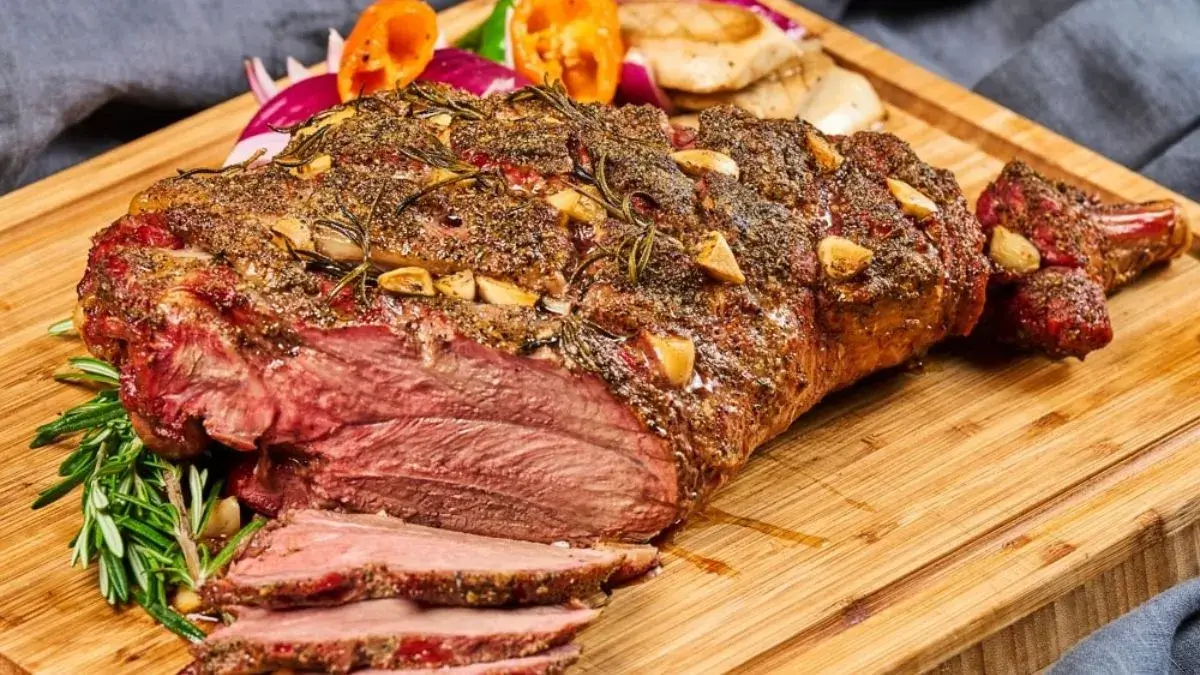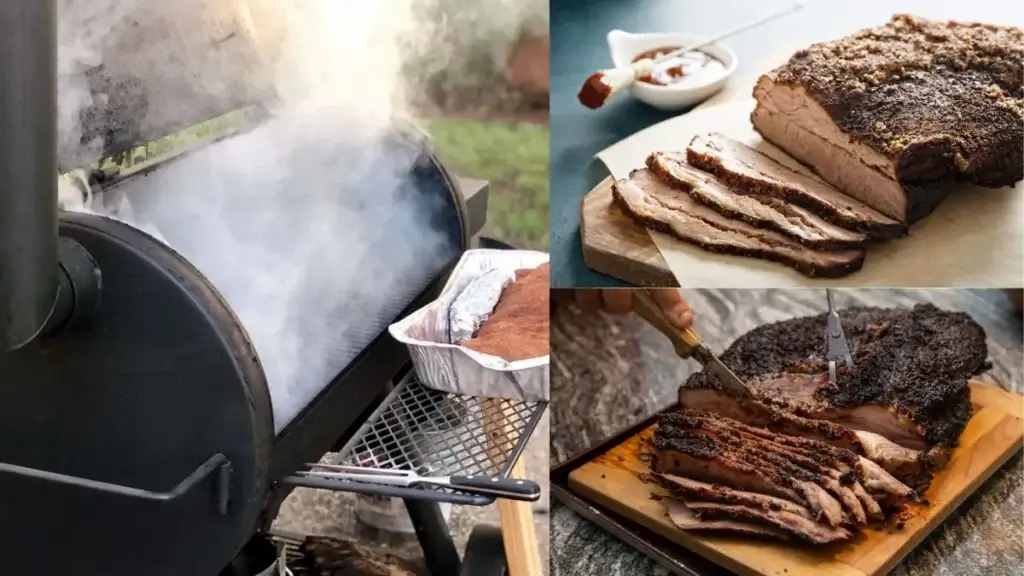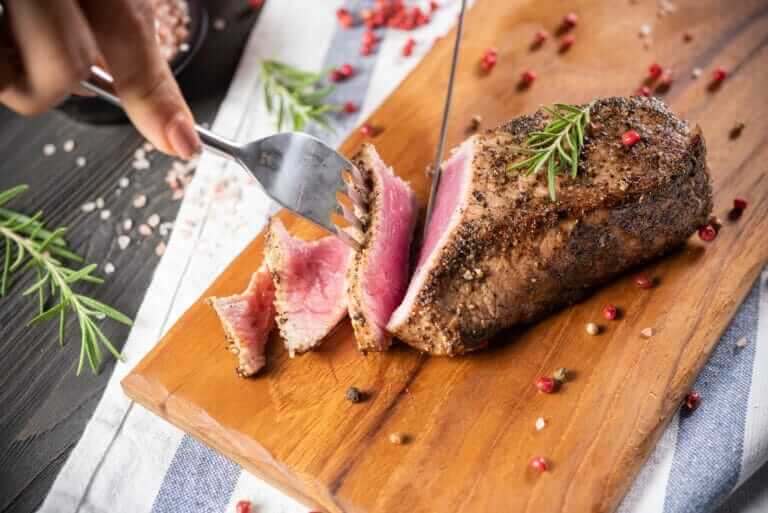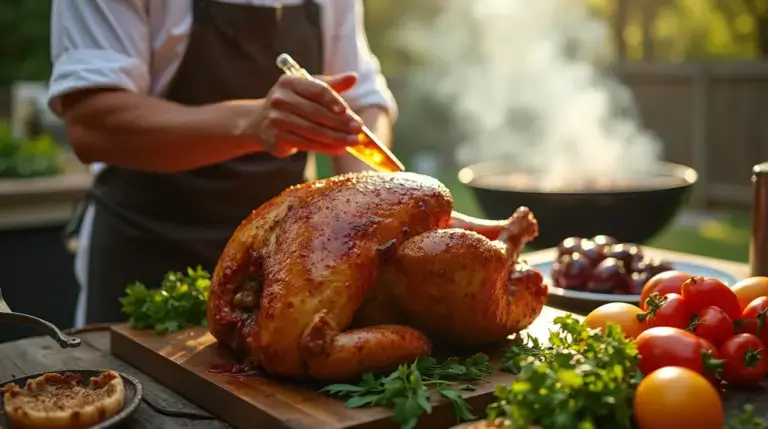Best Smoker Recipes for Delicious Meals
Table of Contents
There’s something special about the smoky smell of a perfectly smoked meal. Whether you’re with friends or enjoying a quiet dinner, smoked foods feel like a warm hug. This guide will help you master smoker recipes and find the best things to smoke.
You’ll learn how to pick the right ingredients, choose the best wood, and control the heat. This way, you can make dishes that taste like they came from a restaurant. Let’s make your backyard a place where every bite tells a story of patience and passion.
Key Takeaways
- Learn smoker recipes that highlight bold, slow-cooked flavors.
- Discover the best things to smoke, from tender meats to caramelized veggies.
- Understand how wood types transform the taste of your dishes.
- Get tips for selecting equipment that suits your cooking style.
- Explore seasonal ingredients to elevate your smoking game year-round.
Introduction to Smoking: The Ultimate Flavor-Enhancing Method
Smoking turns simple ingredients into amazing dishes. It uses heat, smoke, and time. This old method is more than just keeping food fresh. It’s a way to bring out new tastes.
Let’s look at why smoking makes food so delicious. And how it has changed over time.
The Science Behind Smoke Flavor
Smoke particles attach to food, starting chemical reactions. These reactions change proteins and fats into tasty, caramel-like flavors. Important things include:
- Temperature control: Low heat (200–250°F) lets smoke penetrate slowly.
- Wood choice: Hickory or applewood add distinct smoky profiles.
Health Benefits of Smoking Foods
Smoking can be good for you too. When done correctly, it:
- Slows down bacteria growth without using artificial preservatives.
- Helps keep nutrients in meats and veggies.
Ancient Traditions to Modern Techniques
Smoking has changed a lot over time. From the Vikings to today’s pellet grills, here’s how:
| Technique | Era | Method | Example |
|---|---|---|---|
| Smokehouse curing | Ancient | Long-term cold smoke exposure | Smoked salmon |
| Electric smokers | Modern | Precision temperature control | Smoked brisket |
Trying out these methods helps you learn what to smoke. It’s all about respecting tradition while exploring new flavors. Every choice, from the wood to the timing, affects the taste.
Équipement essentiel pour réussir à fumer
Choosing the right smoker is key to great flavors. Start with the right tool for your kitchen or backyard. Let’s break down your options:
- Offset Smokers: Ideal for meats needing bold smoke, like ribs or brisket. They offer hands-on control but require more monitoring.
- Electric Smokers: Great for beginners. They automate temperature control, perfect for wood pellet grill recipes that demand consistency.
- Pellet grills like Traeger or Pit Boss combine automation and smoke flavor. They’re top picks for smoking techniques that balance ease and quality.
- Makeshift setups (e.g., charcoal grill with a water pan) work for small batches or budget-friendly starts.

Accessories make a difference. Invest in a digital thermometer for precise readings. Tongs, heat-resistant gloves, and aluminum foil for wrapping meats are must-haves. For wood pellet grill recipes, check your grill’s manual to pair pellets with dishes like chicken or fish.
“The right equipment turns hobby into art.” – BBQ Magazine
Ask yourself: Do you prioritize convenience or hands-on control? Pellet grills shine for consistent smoking techniques, while vertical smokers excel at low-and-slow cooking. Start small, then expand as your skills grow. This setup ensures you’re ready to tackle ribs, poultry, or even creative wood pellet grill recipes for gatherings.
Understanding Different Wood Types and Their Flavor Profiles
Choosing the right wood is key to getting bold, nuanced flavors in your smoked dishes. Whether you’re grilling ribs or trying out wood pellet grill recipes, knowing how each wood type enhances your meal is crucial.
Hardwoods: Hickory, Oak, and Maple
- Oak: Earthy and robust; perfect for long smokes on hearty meats like chuck roast or lamb.
- Maple: Subtle sweetness without overpowering—pairs well with poultry, salmon, or even tofu for lighter good things to smoke.
- Hickory: Strong, smoky, and slightly sweet, ideal for bold cuts like beef or deer.
Fruit Woods: Apple, Cherry, and Peach
Fruit woods add delicate complexity:
- Apple: Mild sweetness for poultry, cheese, or even vegetables like bell peppers.
- Cherry: Rich, fruity notes that complement duck, “lamb chops, or mushrooms.
- Peach: Light, floral undertones for shrimp, peaches in desserts, or grilled cheeses.
Specialty Woods: Mesquite and Pecan
| Wood | Flavor Profile | Best Pairings |
|---|---|---|
| Mesquite | Intense, bold (use sparingly) | Beef, sausage, or hearty stews |
| Pecan | Nutty, smooth | Chicken, ribs, or vegetables like asparagus |
Wood Pellet Selection for Beginners
When choosing pellets, look for blends labeled for your dish. Opt for hickory-based pellets for robust dishes or fruit wood blends for lighter fare. Always follow package instructions for wood pellet grill recipes and start with small batches to avoid over-smoking. Pairing the right pellets with your good things to smoke ensures every bite bursts with balanced flavor.
The Perfect Smoker Recipe for Beginners: Smoked Chicken Thighs
Starting your smoker recipe adventure? Smoked chicken thighs are the perfect choice. They’re flavorful, forgiving, and work well with any smoker. Follow this guide to create delicious, juicy chicken that will impress on your first try.

Selecting the Right Cut
Choose bone-in, skin-on chicken thighs. These cuts stay moist during the long smoking process and are more forgiving than leaner cuts like chicken breasts. Look for pieces with skin that isn’t torn or overly thick.
“The skin adds crispiness and flavor, while the meat stays juicy,”
Preparation and Seasoning
Dry the chicken thighs with a pat and trim off any excess fat. Coat them with a simple rub of olive oil, salt, black pepper, garlic powder, and smoked paprika. Let the thighs rest at room temperature for 15-20 minutes before smoking.
Smoking Timeline and Temperature Guide
Preheat your smoker to 250°F using fruitwoods like apple or cherry for a mild, sweet smoke.
Arrange the chicken thighs on the smoker grate with the skin facing up. Smoke for 2 hours or until the internal temperature reaches 165°F. For extra crispy skin, finish by raising the temperature to 400°F for the last 10-15 minutes of smoking.Rest the chicken for 5-10 minutes before serving.Watch for flare-ups—if any occur, move the chicken to a cooler spot on the grill to avoid burning.
This method results in juicy, flavorful chicken that’s perfect for beginner smokers. Enjoy!
Mouthwatering Meats: Best Proteins to Smoke

Learning to smoke starts with knowing the best foods to smoke. There are classic cuts and more unique options. Here’s how to choose proteins that will impress on the grill.
Beef isn’t just about brisket. Beef ribs and chuck roast offer deep flavors when smoked slowly. Use oak or hickory for a strong smoky taste. For lamb, try baby back ribs and St. Louis-style cuts with applewood.
Don’t miss out on lamb belly. It turns into delicious bacon when smoked at 225°F for 8 hours.
Chicken thighs with skin-on stay moist. Smoke them at 275°F with maple or cherry wood.
Seafood like salmon or trout absorbs smoke well. Use mild woods like alder and finish at 145°F.
Game meats like venison or wild boar need less smoke time. Opt for mesquite for a strong contrast.
Always check internal temps: 195°F for lamb shoulders, 165°F for poultry. Brine tender meats like turkey overnight before smoking. The good things to smoke also include oysters—wrap them in foil with garlic and smoke until plump.nd smoke until plump. Experiment with rubs but let the protein’s natural taste shine. Your next smoked feast is waiting—try these proteins today!
Beyond Basics: Advanced Smoking Techniques for Enthusiasts
Ready to master the art of smoking? These smoking techniques will take your skills to the next level. You’ll turn simple ingredients into dishes that taste like they’re from a restaurant. Learn how to control temperatures and pair woods for new flavors.
Low and Slow Method
Cook at 200–225°F for 12+ hours to make meat tender. This method breaks down collagen, adding flavor. Wrap meats in foil halfway to keep them moist. Use oak or hickory for a rich taste.
Hot and Fast Approach
Cook at 275–300°F for 2–4 hours for a crispy outside and juicy inside. This is great for tenderloin or chicken thighs. Applewood adds a sweet flavor, and basting keeps meat moist.
Cold Smoking Delicacies
Smoke at under 85°F for light flavors in cheese, fish, or nuts. Cherry or peach woods work well. Try cold-smoked almonds or salmon for a unique taste.
Combination Methods
Combine techniques for complex flavors. Smoke ribs overnight, then sear them. Or cold-smoke salmon before poaching. Our smoker recipe for smoked brisket tacos uses both methods for a balanced taste.
Unexpected Delights: Vegetables and Fruits Worth Smoking
Explore beyond meats by trying good things to smoke from your garden. Vegetables and fruits gain smoky depth when smoked low and slow. This adds a unique twist to your meals. Think about caramelized peaches or smoky roasted cauliflower. These what to smoke ideas can open up new culinary adventures.
Sturdy Vegetables for Smoking
- Cabbage: Brush with olive oil and smoke at 225°F for 2 hours with applewood for tangy slaw.
- Eggplant: Slice and smoke over hickory at 250°F for 1.5 hours, then grill for final char.
- Winter squash: Core and stuff with cinnamon before smoking at 200°F for 3 hours.
Prep tips: Toss veggies in oil first to lock in moisture. Avoid delicate greens like lettuce—they’ll wilt. Use cedar planks for extra aroma.
Fruit Smoking for Desserts and Cocktails
Smoke stone fruits like peaches at 225°F with cherry wood for 45 minutes. Blend into compote or freeze into ice cubes for drinks. Try:
“A smoked apple martini with mesquite-infused vodka? Now that’s a showstopper.” – Chef Maria Lopez, Smoky Harvest Kitchen
Pair smoked apples with vanilla ice cream or chop into salads. For preservation, vacuum-seal smoked berries to use in winter jams.
Trying plant-based what to smoke options can lead to impressive sides, snacks, and desserts. Your smoker isn’t just for ribs anymore!
Troubleshooting Common Smoking Challenges
Even seasoned smokers face hurdles. Let’s tackle the most frequent issues to perfect your smoking techniques and smoker recipe outcomes:
- Temperature swings? Use a digital thermometer to monitor your smoker. On windy days, shield your grill with a windbreak. For electric smokers, preheat fully before adding food.
- Weak smoke flavor? Soak wood chips for 30 minutes before use. Replace damp chips every 1-2 hours. Mix mild and strong woods (e.g., hickory with fruitwoods) for balance.
- Tough meat? Check internal temps with a probe. Lamb should hit 195–205°F. Marinate meats overnight to tenderize. Wrap tough cuts in foil mid-smoke.
- Equipment quirks? Offset smokers need frequent firebox checks. Pellet smokers may jam? Turn off power and gently clear the feed chute. Electric models? Keep vents open for airflow.
Food safety matters! Store leftovers in airtight containers within 2 hours. Reheat smoked meats to 165°F to kill bacteria. Avoid the “danger zone” (40°F–140°F) during storage.
“The best smoker recipe adapts to the moment. Trust your senses—smell, sight, and touch guide you.”
Seasonal Smoking: Adapting Your Techniques Throughout the Year
Learning to adjust with the seasons opens up new possibilities forbest things to smokeall year. By tweaking your wood pellet grill recipes for the weather, you can achieve great results every season.
Summer Smoking Strategies
When it’s hot, efficiency is key. Choose fast-cooking items like corn or peaches to prevent over-smoking. Applewood pellets work well for a crisp finish on summer veggies.
For parties, makewood pellet grill recipeslike peach-stuffed chicken breasts. Smoke them at 225°F for 45 minutes. This balances juicy meat with sweet smoke.
Winter Smoking Adjustments
Cold air takes heat away. Wrap your grill with a tarp and use dense woods like hickory. Choose heartier meats like brisket, smoking them 25% longer to fight the cold.
Go for robustbest things to smokelike maple-smoked stews in a Dutch oven on the grill. This keeps the meat warm and flavorful.
Fall and Spring Specialties
Fall’s cooler air is perfect for apples and game meats. Try cherrywood-smoked Lamb tenderloin with apple slices. In spring, use light fruitwoods for asparagus or artichokes. Both seasons are great for short smokes at 250°F for bright flavors.
By changing fuel, cook times, and ingredients, your grill stays productive all year. Seasonal changes turn weather challenges into chances for creativity.
Conclusion: Elevating Your Culinary Skills Through Smoking

Learning to smoke changes how you cook. You can make everything from tender brisket to smoky veggies. Each time you smoke, you get better, whether it’s balancing flavors or trying new techniques.
Sharing your dishes is a big part of the fun. Join online groups or local events to get better. Try new recipes and mix different woods for unique flavors. As you improve, think about getting a custom smoker or trying dishes from around the world.
Smoking is more than cooking; it’s a creative journey. Every dish you master tells a story. Start small, adjust your grill, and learn from each try. The thrill is in that first perfect bite and the pride of mastering this ancient art. Keep your grill ready, your wood chips on hand, and your mind open. Your next amazing smoked dish is just around the corner.
FAQ
What are the best things to smoke on a wood pellet grill?
Great things to smoke include brisket, ribs, and pulled Lamb. You can also try smoking vegetables like bell peppers and eggplant. Fruits like apples and peaches are great for desserts.
How can I prepare good things to smoke for my next gathering?
Start by picking high-quality ingredients. Season them well with your favorite rubs or marinades. Make sure they’re at room temperature before smoking. Choose the right wood type to match your food’s flavor.
What smoking techniques should beginners learn first?
Beginners should learn the low and slow method for meats. This makes them tender and flavorful. It’s also important to know how to control temperatures and cooking times.
Are there any specific wood pellet grill recipes that are easy to follow?
Yes, simple recipes like smoked chicken wings, pulled beef or pulled Lamb are great for beginners. They require little prep but taste amazing.
How do I troubleshoot common smoking problems?
Common problems often come from temperature control and smoke quality. Keep your smoker at a steady heat and don’t overload it. If flavors are bitter, check for too much smoke or dirty wood. Patience and following guidelines can help solve these issues.
What types of vegetables and fruits are worth smoking?
Vegetables like zucchini, carrots, and cauliflower take smoke flavor well. Stone fruits like peaches and pineapples are perfect for desserts or cocktails.
Can I smoke seafood, and if so, which types work best?
Yes, you can smoke seafood! Salmon, shrimp, and whole fish are great options. Oysters also smoke well, adding a unique flavor.
How should I adjust my smoking techniques for different seasons?
In summer, use lighter, quicker recipes due to high temperatures. In winter, insulate your smoker to keep heat in. Adjust wood choices and cooking times for better results.







